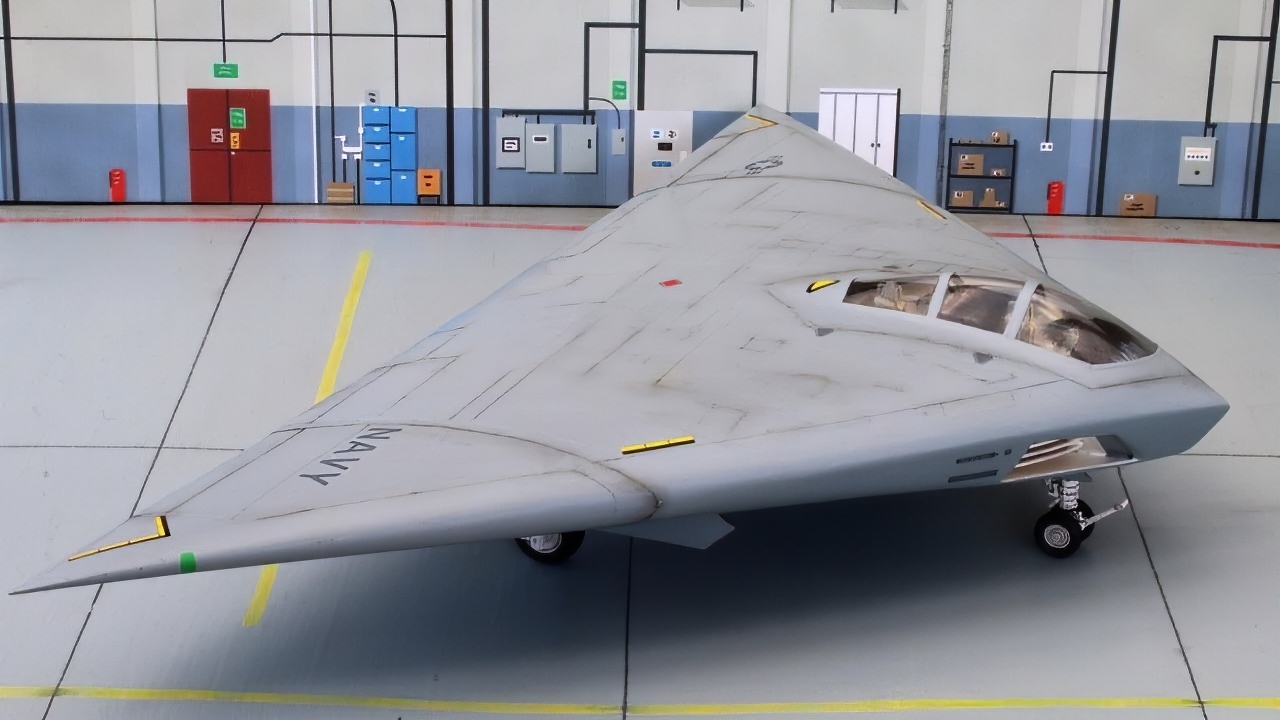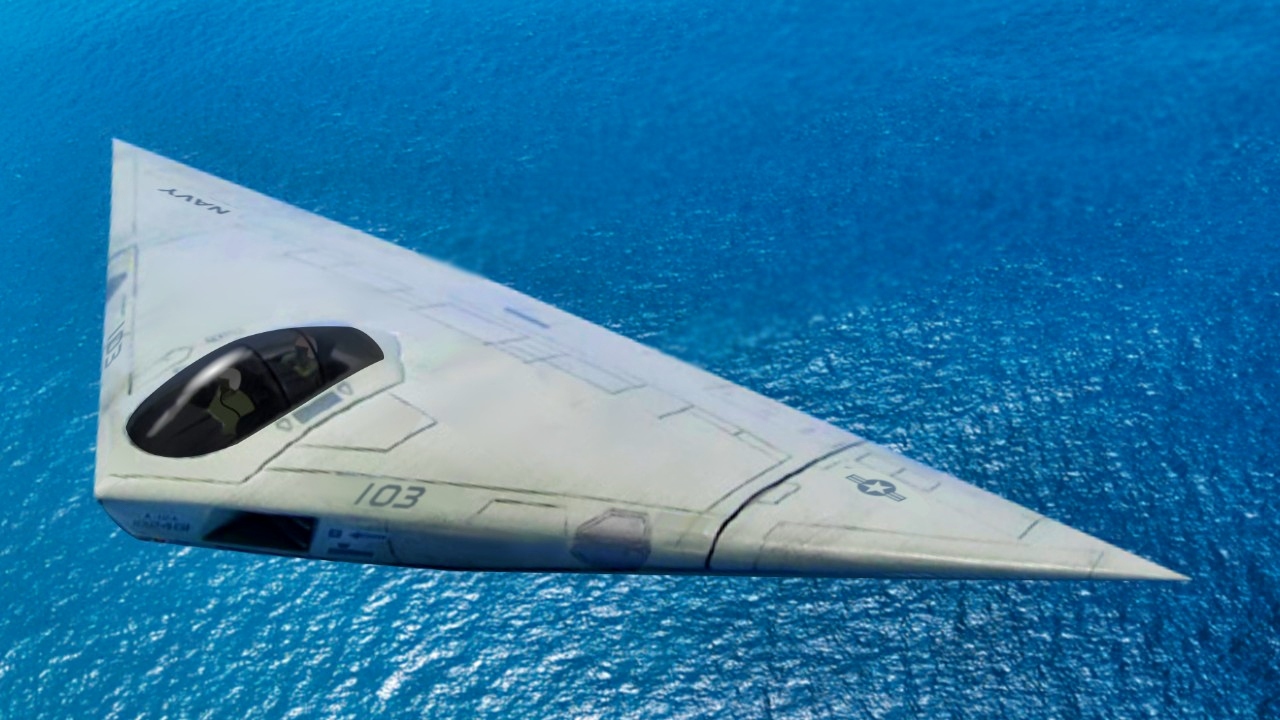PUBLISHED on August 9, 2025, 09:18 AM EDT – Key Points and Summary – The A-12 Avenger II, nicknamed the “Flying Dorito,” was the U.S. Navy’s ambitious 1980s program to field a carrier-based stealth attack aircraft to replace the A-6 Intruder.
-However, the project was a colossal failure, plagued by massive cost overruns, significant weight problems, and unresolved technological hurdles.

A-12 Avenger II Flying Dorito. Image Credit: Creative Commons.
-In 1991, after $5 billion had been spent on a single mockup, Defense Secretary Dick Cheney canceled the program in what became the largest contract termination in Pentagon history.
-A culture of excessive secrecy and poor communication between the contractors and the Navy was a key factor in its demise.
Why Did The A-12 Avenger II Fail?
In 1983, the Air Force introduced the first stealth aircraft, the F-117 Nighthawk stealth fighter. The Navy wanted its own stealth capability for an attack aircraft that could replace the A-6 Intruder.
The result was the intriguing A-12 Avenger II, known sometimes as “The Flying Dorito” because of its flying-wing shape.
The A-12, developed as a joint venture by Boeing and General Dynamics, was canceled in 1991 due to cost overruns, weight issues, and technological hurdles – in particular, the difficulty of landing a drone on a moving carrier.
Meet The “Flying Dorito”, The A-12 Avenger II
Around the same time the F-117 was being developed as part of the Advanced Tactical Aircraft program in the early 1980s, the stealthy A-12 was envisioned to replace the A-6 Intruder.
The McDonnell Douglas/General Dynamics team was selected in 1988.
The first flight was planned for December 1990. The A-12 was named Avenger II in honor of the World War II-era Grumman TBF/TBM torpedo bomber.
The Navy initially wanted 620 A-12s. The Marines wanted 238, and the Air Force considered 400 A-12 variants as a replacement for its retiring F-111 Aardvarks.

F-111. Image Credit: Creative Commons.
The “Flying Dorito” did not have a large payload. It could carry only 5,150 pounds of ordnance, far less than the 18,000 pounds the Intruder carried. The intent was to develop an aircraft that could enter contested airspace unseen by radars and drop precision munitions.
Alex Howlings from Sandboxx News and Airpower wrote, “like modern stealth aircraft in operation today, the A-12 Avenger was never intended to scream into the fight with its teeth bared. In the minds of many defense officials, its ability to strike targets without warning in highly contested airspace was more useful than a massive payload… Instead, stealth combined with highly accurate precision munitions would allow the A-12 Avenger II to surgically strike enemy targets where it hurt most.”
The Avenger II would carry two air-to-air missiles. It would also equip two AGM-88 High-Speed Anti Radiation Missiles that could home in on the electromagnetic waves emanating from early-warning radar arrays and surface-to-air missile platforms.
The A-12 Avenger II would have played a similar role in contested airspace to today’s F-35 Joint Strike Fighters. It wouldn’t have been a bomb truck like the A-6, but rather a fighter that would take out a target quickly.
Why The A-12 Was Canceled
As Simple Flying posted, the A-12 program was “late, overweight, and over budget.” Its cancellation was the largest project termination in the history of the U.S. Department of Defense. After spending $5 billion on research and development, the only A-12 Avenger II built was a mockup.
Its cancellation led to long-running litigation as the government sought to retrieve some of the funding it had disbursed to contractors. The case was not settled until 2014, when the contractors agreed to repay a lower sum.
Aviation historian James Stevenson wrote a book on the subject, in which he stated that changes in leadership, objectives, and funding “were bound to devastate the program.” However, part of the problem was the Pentagon itself, with its incredibly complicated system of procurement.
Issues That Ultimately Sank The Program
When then-Defense Secretary Dick Cheney canceled the program in January 1991, it sent shockwaves through the defense industry and the Pentagon. The U.S. was wrapping up one war in Panama and getting ready to kick off the air campaign for Operation Desert Storm.
Air & Space Forces wrote about four factors that doomed the program.
Overly protective Navy officials, who didn’t want to endanger the plane by pointing out problems. A Navy program manager continued to describe the A-12 as being on track until after a central Pentagon review in 1990.
-A “don’t-rock-the-boat” segment of the Pentagon bureaucracy, which was aware of problems but reluctant to go against the wishes of superiors. In one incident, a report noting some problems with the A-12 was tucked away and forgotten.
-Overly optimistic A-12 contractors, who miscalculated the extent of the technical difficulties in producing such a plane and shielded those problems from the government. An inquiry by Navy Deputy General Counsel Chester Paul Beach found that General Dynamics and McDonnell Douglas discovered “increasing cost and schedule variances” but did not alert the Navy in a timely fashion.
-Excessive secrecy, which blanketed the project and prevented examinations that might have brought problems to light. Officials assigned to defense secretaries were kept away from the project, standard reporting procedures were abandoned, and information was transmitted verbally rather than in writing.
Suspicion and Ambition Between Contractors
Under a $4.8 billion Pentagon contract, General Dynamics and McDonnell Douglas were to develop the A-12 and build eight prototypes.
Neither company had experience applying the composite materials that would clad the stealthy parts of the airframe and wings. Worse, the two companies did not want to share sensitive technologies on this project because they were rivals on the program to build the Air Force’s Advanced Tactical Fighter.
One Pentagon analyst noted, “There were technologies that could have helped in the overall [A-12] effort, but they weren’t willing to share those.
“If you have a technological advantage, how willing are you to share that if…it could help you in some other program?”
Delays and Cost Overruns Kept From SecDef Cheney
The contractors were far behind schedule and way over the budget, but they kept that news from Cheney, who shared with Congress the rosy reports he steadfastly received.
Once Cheney learned about all the issues that had been kept from him, the A-12’s days were numbered.
The secretary called a “show cause” meeting that many assumed would result in a government bailout to keep the airplane going. The program was 18 months behind schedule, far over budget, and the aircraft was overweight by more than 8,000 pounds.
Cheney met for about an hour and a half with a smaller group that included Joint Chiefs of Staff Chairman Gen. Colin Powell, Deputy Defense Secretary Donald J. Atwood, and a few others.
The choices boiled down to three options: carrying out the existing contract despite its problems, modifying the contract to bail out the manufacturers, or terminating the program.
Most agreed that the contract was not going to work. The choice was between a bailout and a termination, and the issue focused on money. Cheney refused a bailout. Two days later, the Navy canceled the contract for default.
General Dynamics and McDonnell Douglas stated they disagreed that they were in default, and would contest Cheney’s decision, as well as his opinion of the program.
Long Litigation Follows:
In the following years, the two companies would go through five trials and two appeals against the government, with the case eventually reaching the Supreme Court.
In January of 2014, Boeing, which had taken over McDonnell Douglas, and General Dynamics agreed to repay the government $200 million each for failing to meet the requirements of the initial contract.
About the Author:
Steve Balestrieri is a National Security Columnist. He served as a US Army Special Forces NCO and Warrant Officer. In addition to writing on defense, he covers the NFL for PatsFans.com and is a member of the Pro Football Writers of America (PFWA). His work was regularly featured in many military publications.
Defense Watch
F/A-XX Is the YF-23 on a Carrier?











bockscar
August 9, 2025 at 10:55 am
The A-12 failed because it wasn’t an attack intruder for the air force strategic commandvthat cane fully armed with CIA support.
Moreover, the A-12’s thick wings couldn’t be folded.
The CIA is part of the deep state, and without deep state support, a weak spineless guy like Cheney could easily wrestle you to the floor.